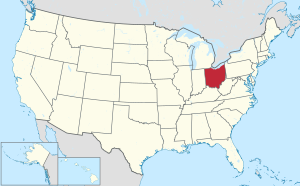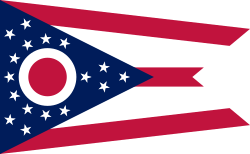Ohio: Difference between revisions
No edit summary |
No edit summary |
||
| Line 1: | Line 1: | ||
{{ | {{Header| 08/22}} | ||
{{State | {{State | ||
| state = Ohio | | state = Ohio | ||
Latest revision as of 01:50, 14 May 2025
| Ohio |
Jon Husted (R) |
5 Democrats |
Ohio is a state in the Midwestern region of the United States. Of the fifty U.S. states, it is the 34th largest by area, and with a population of nearly 11.8 million, it is the seventh most populous and tenth most densely populated. The state's capital and largest city is Columbus, with the Columbus metro area, Greater Cincinnati, and Greater Cleveland as the largest metropolitan areas. Ohio is bordered by Lake Erie to the north, Pennsylvania to the east, West Virginia to the southeast, Kentucky to the southwest, Indiana to the west, and Michigan to the northwest. Ohio is historically known as the "Buckeye State" after its Ohio buckeye trees, and Ohioans are also known as "Buckeyes". Its state flag is the only non-rectangular flag of all the U.S. states.
The state takes its name from the Ohio River, whose name, in turn, originated from the Seneca word ohiːyo', meaning "good river", "great river", or "large creek". Ohio arose from the lands west of Appalachia that were contested from colonial times through the Northwest Indian Wars of the late 18th century. It was partitioned from the resulting Northwest Territory, which was the first frontier of the new United States, and became the 17th state admitted to the Union on March 1, 1803, and the first under the Northwest Ordinance. Ohio was the first post-colonial free state admitted to the union and became one of the earliest and most influential industrial powerhouses during the 20th century. Although Ohio has transitioned to a more information- and service-based economy in the 21st century, it remains an industrial state, ranking seventh in GDP as of 2019, with the third largest manufacturing sector and second largest automobile production.
The government of Ohio comprises the executive branch, headed by the governor; the legislative branch, which includes the bicameral Ohio General Assembly; and the judicial branch, overseen by the state Supreme Court. Ohio holds 16 seats in the United States House of Representatives. The state is recognized for its role as both a swing state and a bellwether in national elections. Seven presidents of the United States hail from Ohio, earning it the moniker "the Mother of Presidents."
Entymology
The state takes its name from the Ohio River, whose name, in turn, originated from the Seneca word ohiːyo', meaning "good river", "great river", or "large creek".
Attitudes toward the LGBTQ+ community in Ohio
Attitudes toward the LGBTQ+ community in Ohio reflect a complex interplay between growing public support and legislative challenges.
- Public Opinion
Support for LGBTQ+ rights in Ohio has grown over time. A 2022 survey by the Public Religion Research Institute (PRRI) found that 70% of Ohioans supported same-sex marriage, a significant increase from 56% in 2016 and 52% in 2012.
- Legal Protections and Policies
Despite shifting public opinion, Ohio lacks comprehensive statewide protections for LGBTQ+ individuals.
- Statewide Protections: Ohio does not have laws explicitly prohibiting discrimination based on sexual orientation or gender identity in employment, housing, or public accommodations.
- Local Ordinances: Approximately 31% of Ohio's population is covered by local ordinances that fully protect against discrimination based on sexual orientation and gender identity. Cities like Columbus, Cleveland, Cincinnati, Dayton, and Toledo have enacted such measures.
- Recent Legislation: In November 2024, Governor Mike DeWine signed the "Protect All Students Act," which mandates that students use bathrooms and locker rooms corresponding to their sex assigned at birth in schools. The law has faced criticism from civil rights groups for infringing on LGBTQ+ rights.
- Community and Advocacy
Despite legal challenges, Ohio's LGBTQ+ community remains active and resilient.
- Advocacy Groups: Organizations like Equality Ohio and the ACLU of Ohio work to advance LGBTQ+ rights through legal advocacy and public education.
- Community Support: Urban areas tend to be more accepting, with active LGBTQ+ communities and events. However, acceptance can vary in rural regions.
- Ongoing Challenges
LGBTQ+ individuals in Ohio continue to face several challenges:
- Youth Experiences: A 2017 survey found that 73% of LGBTQ+ middle and high school students in Ohio experienced verbal harassment based on their sexual orientation at school.
- Mental Health: The Trevor Project's 2022 survey indicated that LGBTQ+ youth in Ohio who live in accepting communities report significantly lower rates of attempting suicide.
History of the Ohio Flag
The Ohio State Flag features a burgee shape, which is a rectangle with a triangle cut out of the fly side of the flag. Ohio is the only U.S. state that utilizes this unique design. The flag has five alternating red and white stripes, with a blue triangular field on the hoist side pointing towards the fly side. A red circle, outlined with a thick white border, is centered in the blue triangle. Surrounding the circle are 17 white five-pointed stars; 13 of these stars encircle the circle, while 4 are located in the apex. The red and white stripes represent the roads and waterways of the state, while the circle symbolizes the letter "O," which stands for "Ohio." The red circle also represents the seed of the buckeye tree, which is Ohio's official state tree. The blue triangle signifies the hills and valleys of the state, and the 13 stars surrounding the circle represent the 13 original colonies. The total of 17 stars indicates that Ohio was the 17th state to enter the Union. The Ohio State Flag was designed by John Eisemann and adopted on May 9, 1902. Eisenmann was an architect and resident of Cleveland, Ohio, renowned for designing many notable buildings in the state, including those at Case Western University, where he was a professor.
Ohio is located in the Great Lakes region of the United States of America. It shares borders with Pennsylvania, Michigan, Lake Erie, Indiana, Kentucky, and West Virginia. Columbus is the largest city in the state and has been the capital since 1816. Ohio was named after the Ohio River, which derives from the Iroquois word "Ohi-yo," translating to "continuously-spilling creek." Ohio is also referred to as "The Buckeye State" due to its famous buckeye trees, which produce small brown nuts resembling the eye of a deer. It is sometimes called "The Mother of Presidents" since seven Presidents of the United States have been born in Ohio.
Ohio has been inhabited for thousands of years, with the earliest residents being mound-building cultures such as the Hopewell and Adena peoples. During the 1600s, the Iroquois Indians moved into the region, followed by tribes such as the Delaware, Shawnee, and Miami. The first European to arrive in the area was French explorer Robert De La Salle in 1669, when he claimed the land for France. During the 1700s, British colonists began to arrive in search of land, leading to conflicts between the French and the English, which culminated in the French and Indian War in 1754.
In 1763, the English defeated the French during the war and took control of Ohio. In 1783, following the Revolutionary War, Ohio became part of the United States of America, and in 1787, the Northwest Territory was created, which included Ohio, Illinois, Indiana, Michigan, Wisconsin, and Minnesota. The first permanent settlement was established in 1788, called Marietta (after Marie Antoinette), and on March 1st, 1803, Ohio officially became the 17th state of the United States of America.
External links
- Wikipedia article: Ohio
Chat rooms • What links here • Copyright info • Contact information • Category:Root

